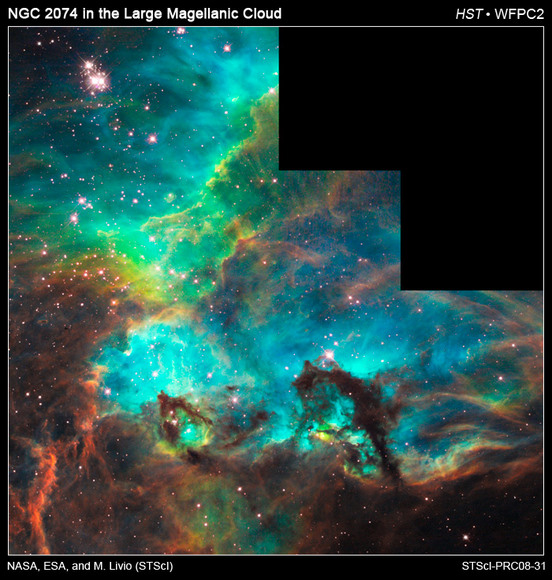[/caption]
This morning at 7:42 EDT, the Hubble Space Telescope completed it's 100,000th orbit around the Earth. That's about 4.38 billion kilometers (2.72 billion miles), as it clicks along at 8 km per second (5 miles/s), orbiting Earth once every 90 minutes. Hubble's been in orbit for over 18 years now, since its launch on the space shuttle Discovery on April 24, 1990. To commemorate occasion, scientists at the Space Telescope Science Institute in Baltimore, Md., released a special image taken with Hubble's Wide Field Planetary Camera 2 of a nebula near the star cluster NGC 2074 (upper, left) , showing a dazzling region of celestial birth and renewal. And soon, Hubble will have a little renewal of its own, with the upcoming fifth and final servicing mission in October.
In preparation for the STS-125 servicing mission to Hubble, on Friday engineers mated the external tank (ET-127) to the two solid rocket boosters. Things are going well with getting Atlantis ready to go, and NASA is looking at actually moving up the launch date for the mission a few days, from the currently scheduled October 8 to October 2. Read more about the mission
here
, and interviews with the seven astronauts who will be part of the mission are available to read on that page, or you can watch them on
NASA TV
this week.
The above image released today shows a firestorm of raw stellar creation, perhaps triggered by a nearby supernova explosion. It lies about 170,000 light-years away near the Tarantula nebula, one of the most active star-forming regions in our Local Group of galaxies. This representative color image was taken just yesterday on August 10, 2008. Red shows emission from sulfur atoms, green from glowing hydrogen, and blue from glowing oxygen.
Hubble remains in orbit without any fuel; it just uses its speed and Earth's gravity to maintain its circular orbit, and gyroscopes to maintain the correct attitude. The astronauts on Atlantis will make one final mechanic's check to replace worn gyroscopes, batteries and a fine guidance sensor and to install new instruments to extend Hubble's vision. These include a new Wide Field Camera 3 and a Cosmic Origins Spectrograph, to observe the light put out by extremely faint, far-away quasars.
Hubble has been an incredible spacecraft that has changed our view of the universe. Happy 100,000th orbit Hubble!
Source:
Hubblesite
 Universe Today
Universe Today
